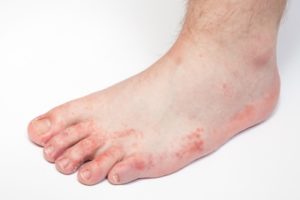Tips for Reducing Your Risk of Toenail Fungus
 Dermatophytes are the microorganisms that are usually responsible for foot fungus. The nails are a veritable feast for these fungi, as the nails contain plenty of the protein keratin that dermatophytes like to eat. The yellowish discoloration, thickened, and deformed appearance of fungal toenails can be embarrassing, but a podiatrist can help you heal your feet and reduce your risk of recurrent infections. Residents of the Chicago area can prevent toenail fungus with these easy tips.
Dermatophytes are the microorganisms that are usually responsible for foot fungus. The nails are a veritable feast for these fungi, as the nails contain plenty of the protein keratin that dermatophytes like to eat. The yellowish discoloration, thickened, and deformed appearance of fungal toenails can be embarrassing, but a podiatrist can help you heal your feet and reduce your risk of recurrent infections. Residents of the Chicago area can prevent toenail fungus with these easy tips.
Maintain good foot hygiene.
Scrub your feet thoroughly every day. If you usually shower in the morning, take a few minutes to stick your feet in the tub before bedtime. Scrub them well to eliminate the sweat and grime accumulated during the day. Your podiatrist might recommend applying a topical medication to your skin or toenails after drying your feet.
Keep your feet dry.
Fungi thrive in warm, moist environments. Keeping your feet dry throughout the day can be challenging, but your efforts will be rewarded with healthier, fungus-free toenails. Dust foot powder on your clean, dry feet before putting on socks and shoes in the morning. Choose lightweight, breathable socks that wick moisture away from your skin. Similarly, wear shoes made from a breathable mesh material. On very hot or active days, bring a spare pair of socks with you to change into later.
Prevent fungal infections from public places.
Foot fungus spreads easily in gym locker rooms, public showers, and public pools. Although podiatrists generally advise against wearing flip-flops, they do recommend flip-flop use in these areas when the alternative is going barefoot. College students should always wear flip-flops in communal showers, and patients who expect to be hospitalized should bring a pair of shower shoes in their overnight bag.
Avoid sharing certain items.
Foot fungus can hitch a ride on nail clippers, files, pumice stones, and even nail polish applicators. Avoid lending your personal products, and don’t borrow anyone else’s. It goes without saying that it’s not a smart move to share socks and shoes.
Use an at-home pedicure kit.
Nail salons are supposed to follow strict sanitation regulations, but not all of them do. Foot fungus is often acquired from footbaths and instruments, so consider giving yourself a pedicure at home instead.
